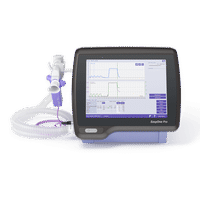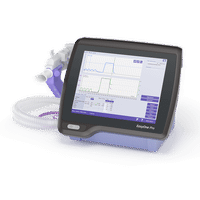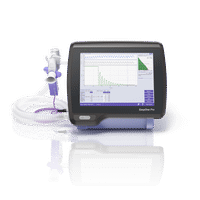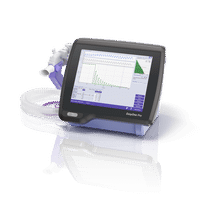PFT testing for cardiopulmonary disease

The importance of accurate pulmonary function testing for cardiopulmonary disease #
In 2016, nearly 31 percent of all global fatalities were attributed to cardiovascular diseases (CVDs). Data from the World Health Organization likewise verifies that 85 percent of the 17.9 million CVD deaths were caused by heart attack or stroke.1
Due to the overlap in physiology, obstructions and complications in the lungs can directly impact cardiovascular health.2 Consequently, like any other chronic medical condition, early diagnosis is the pathway to mitigation, treatment, and living a higher quality of life.
Risk factors for cardiovascular diseases, such as smoking and a sedentary lifestyle, pose an increased risk of lung disease for patients.3 While education, intervention, and mitigation efforts can significantly reduce cardiopulmonary disease, effective lung function testing is crucial for early diagnosis and treatment.
Pulmonary function tests form the mainstay for the evaluation of lung diseases and associated co-morbidities. Through pulmonary function testing (PFT) via spirometry or portable DLCO, cardiologists and healthcare providers can easily and conveniently complete robust, accurate, and non-invasive testing to accurately diagnose.
The link between pulmonary function and cardiovascular disease #
If the heart is the power plant that supplies life-giving blood to the body, the lungs are the fuel source. The efficiency of the respiratory system helps to establish a strong cardiovascular system. While these two systems operate independently, they are linked together in multiple ways.
Risk factors
A common risk factor for heart failure (HF) and COPD is cigarette smoking.4 Hence these two conditions coexist frequently in the same patient. Moreover, these conditions often present similar symptoms (dyspnea, exercise intolerance, muscle weakness, sleep disturbances, cachexia, and anxiety).5 This complicates the accurate diagnosis of either condition in a clinical setting.
Cardiopulmonary interactions are a critical component of HF.6 In fact, there have been many reports which point towards the following:
- The significance of pulmonary congestion in HF
- The impact of concomitant lung disease on HF course and prognosis
- The probable effects of COPD therapies on heart function; and
- The potential impacts of HF therapies on lung function.
Mitigation efforts
It’s well understood that most cardiovascular and pulmonary diseases can be prevented by addressing and mitigating risk factors including the use of tobacco products, an unhealthy diet, physical inactivity, alcohol consumption, and the onset of obesity.
Moreover, people who are currently living with a cardiovascular disease or who may be vulnerable due to risk factors such as diabetes, hypertension, hyperlipidemia, or other established diseases, require early detection and management through education, therapy, counseling, and medication.
Spirometry and PFT testing is a solution for the proactive cardiologist #
While it’s often assumed that spirometry is a lung-health specific diagnostic tool, it also plays a vital role in assessing cardiovascular risk, including coronary artery disease. A study published in the Annals of the American Thoracic Society reported that a restrictive pattern on spirometry and airflow obstruction identify African Americans with impaired lung health at risk for heart failure.7
Additionally, recent technical advances and the accessibility to portable devices allowing the measurements of spirometry and diffusing lung capacity for carbon monoxide (DLCO) outside of hospitals and pulmonary function laboratories could help offer the ideal solution.
This is validated by new research whereby a rapid decline in lung function (measured by spirometry) was associated with a higher incidence of heart failure and other cardiovascular disease outcomes.
- Shah et al. showed in a community-based cohort (with more than 10,000 participants enrolled in the prospective Atherosclerosis Risk in Communities study) that a rapid decline in forced expiratory volume in 1 second (FEV1) was associated with a fourfold increased risk of incident heart failure in the first year of follow-up.8
- In the study, a rapid decline in lung function measured by forced vital capacity (FVC) was associated with an elevated risk of heart failure throughout approximately 17 years of follow-up.
- They found that neither sex nor race affected these associations.
It is important to note that PFT using both spirometry and DLCO measurements should be considered complementary to clinical assessment, echocardiography, and cardiac biomarkers (natriuretic peptides and chest imaging). Additionally, lung function parameters provide prognostic information in patients with HF and may help to guide treatment decisions.
ndd Medical solutions for cardiologists #
The pathway to superior cardiovascular patient care
Greater collaboration between cardiologists and pulmonologists helps identify a decline in lung function as well as the onset of cardiovascular diseases early. This would facilitate better disease management to prevent rapid disease progression and avoid overt cardiovascular disease risk.
As a result, spirometry and DLCO measurements should be recommended as part of the initial diagnostic procedure and follow‐up in patients with HF and other cardiovascular diseases. The use of ndd Medical EasyOne products allows today’s cardiologist to complete rapid PFT and spirometry examinations, deliver robust and accurate results, with ease of use and without complicated or time-consuming calibration.
To learn more, click on the ndd solutions below.


EasyOne Pro
Portable DLCO, Lung Volumes and Spirometry


EasyOne Pro LAB
Portable DLCO, MBW, Lung Volumes, LCI and Spirometry
World Health Organization. Cardiovascular diseases (CVDs), https://www.who.int/en/news-room/fact-sheets/detail/cardiovascular-diseases-(cvds) (2017, May 17). ↩︎
Maclay, J. D., McAllister, D. A. & Macnee, W. Cardiovascular risk in chronic obstructive pulmonary disease. Respirology 12, 634-641, doi:10.1111/j.1440-1843.2007.01136.x (2007). Macnee, W., Maclay, J. & McAllister, D. Cardiovascular injury and repair in chronic obstructive pulmonary disease. Proc Am Thorac Soc 5, 824-833, doi:10.1513/pats.200807-071TH (2008). Wang, B. et al. Association of lung function with cardiovascular risk: a cohort study. Respir Res 19, 214, doi:10.1186/s12931-018-0920-y (2018). Morgan, A. D., Zakeri, R. & Quint, J. K. Defining the relationship between COPD and CVD: what are the implications for clinical practice? Ther Adv Respir Dis 12, 1753465817750524, doi:10.1177/1753465817750524 (2018). ↩︎
Shinton, R. & Beevers, G. Meta-analysis of relation between cigarette smoking and stroke. BMJ 298, 789-794, doi:10.1136/bmj.298.6676.789 (1989). Anderson, K. M., Wilson, P. W., Odell, P. M. & Kannel, W. B. An updated coronary risk profile. A statement for health professionals. Circulation 83, 356-362, doi:10.1161/01.cir.83.1.356 (1991). Ockene, J. et al. Smoking cessation and severity of disease: the Coronary Artery Smoking Intervention Study. Health Psychol 11, 119-126, doi:10.1037//0278-6133.11.2.119 (1992). Warren, T. Y. et al. Sedentary behaviors increase risk of cardiovascular disease mortality in men. Med Sci Sports Exerc 42, 879-885, doi:10.1249/MSS.0b013e3181c3aa7e (2010). Fletcher, G. F. et al. Promoting Physical Activity and Exercise: JACC Health Promotion Series. J Am Coll Cardiol 72, 1622-1639, doi:10.1016/j.jacc.2018.08.2141 (2018). ↩︎
de Miguel Diez, J., Chancafe Morgan, J. & Jimenez Garcia, R. The association between COPD and heart failure risk: a review. Int J Chron Obstruct Pulmon Dis 8, 305-312, doi:10.2147/COPD.S31236 (2013) ↩︎
Morgan, A. D., Zakeri, R. & Quint, J. K. Defining the relationship between COPD and CVD: what are the implications for clinical practice? Ther Adv Respir Dis 12, 1753465817750524, doi:10.1177/1753465817750524 (2018). Alpert, C. M., Smith, M. A., Hummel, S. L. & Hummel, E. K. Symptom burden in heart failure: assessment, impact on outcomes, and management. Heart Fail Rev 22, 25-39, doi:10.1007/s10741-016-9581-4 (2017). Wust, R. C. & Degens, H. Factors contributing to muscle wasting and dysfunction in COPD patients. Int J Chron Obstruct Pulmon Dis 2, 289-300 (2007). ↩︎
Agostoni, P., Cattadori, G., Bussotti, M. & Apostolo, A. Cardiopulmonary interaction in heart failure. Pulm Pharmacol Ther 20, 130-134, doi:10.1016/j.pupt.2006.03.001 ↩︎
Jankowich, M. et al. Restrictive Spirometry Pattern, Cardiac Structure and Function, and Incident Heart Failure in African Americans. The Jackson Heart Study. Ann Am Thorac Soc 15, 1186-1196, doi:10.1513/AnnalsATS.201803-184OC (2018). ↩︎
Silvestre, O. M. et al. Declining Lung Function and Cardiovascular Risk: The ARIC Study. J Am Coll Cardiol 72, 1109-1122, doi:10.1016/j.jacc.2018.06.049 (2018). ↩︎







